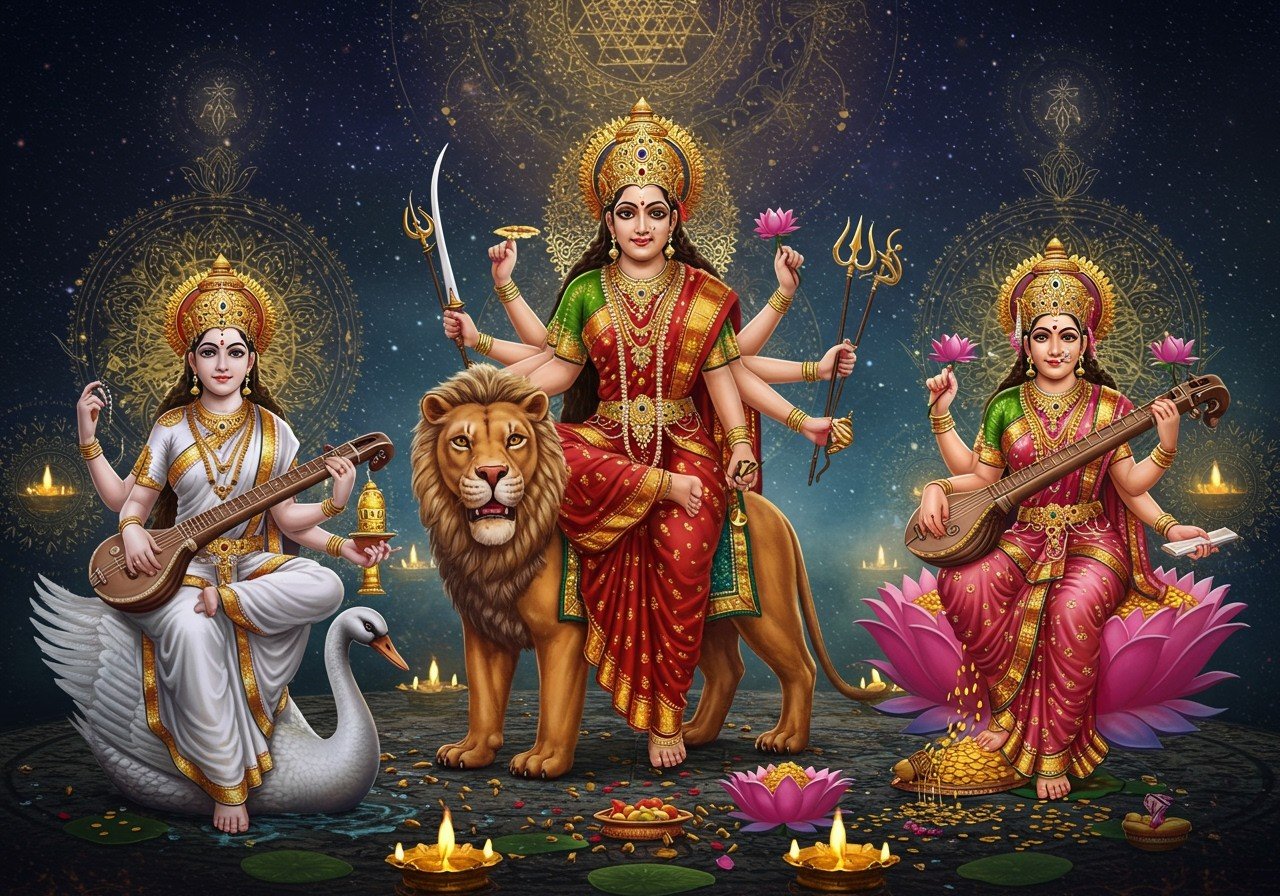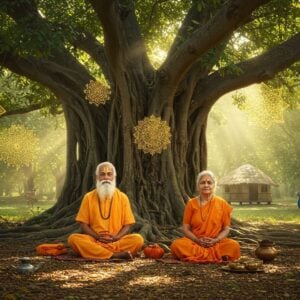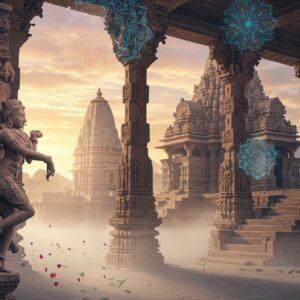
The Divine Feminine in Hinduism is a captivating aspect, deeply woven into our history and culture. It encompasses a rich tapestry of goddesses and feminine energy, revered for millennia. As we move through 2025, the portrayal and worship of the Divine Feminine continue to evolve, beautifully blending ancient traditions with contemporary practices.
Devi: The Supreme Goddess
In Hinduism, Devi reigns supreme as the ultimate embodiment of the Divine Feminine. She symbolizes the very essence of cosmic energy, a vital force in the continuous cycle of creation, preservation, and destruction. Devi manifests in countless forms, each with unique qualities and significance. Some of the most prominent forms include Durga, Lakshmi, and Saraswati, each representing different facets of life and the universe.
- Durga: Known for her unparalleled strength and unwavering courage, Durga is the protector of the righteous, shielding the world from the forces of evil. Her image evokes a sense of security and inspires courage in the face of adversity. You can find exquisitely crafted Durga Maa idols at poojn.in, perfect for your home altar.
- Lakshmi: The goddess of wealth and prosperity, Lakshmi bestows fortune and abundance upon her devotees. She is a symbol of hope and material well-being, reminding us of the importance of both spiritual and worldly success. Invite prosperity into your home with a beautiful Lakshmi and Ganesha idol available at poojn.in.
- Saraswati: As the goddess of knowledge, music, art, speech, wisdom, and learning, Saraswati is a source of inspiration for creativity and intellectual pursuits. She encourages us to seek knowledge and express ourselves through various art forms. Celebrate her blessings with authentic puja items from poojn.in.
Navaratri, the vibrant nine-night festival dedicated to Devi, is a powerful testament to her presence and influence. Celebrated with immense devotion across India, it involves fasting, heartfelt prayers, and captivating cultural performances. Navaratri reaffirms the profound significance of the Divine Feminine in our rich Hindu heritage.
Shakti: The Dynamic Energy of the Divine Feminine
Shakti embodies the dynamic energy, the very life force that pulsates through the universe. This vibrant energy fuels creation and empowers both goddesses and mortals. Shakti represents the power to transform and renew, a force that is both awe-inspiring and deeply revered.
- Kali: A fierce and powerful manifestation of Shakti, Kali symbolizes the cyclical nature of time, change, and transformation. Her energy is raw and potent, representing the universe’s power to both create and destroy. Embrace her transformative energy and find inner strength through her symbolism.
- Parvati: As the consort of Lord Shiva, Parvati represents the nurturing and compassionate aspect of Shakti. She embodies love, devotion, and beauty, reminding us of the gentler side of divine power. Find beautiful Maa Tara murtis at poojn.in to honor this aspect of the Divine Feminine.
Even in 2025, Shakti continues to inspire spiritual practices and personal empowerment. Many seek solace and strength in her energy, finding ways to connect with this divine force in their daily lives. Shakti remains a timeless source of guidance and inspiration in our modern world.
Goddesses in Hindu Epics
Our Hindu epics, like the Ramayana and Mahabharata, feature powerful goddesses who play pivotal roles in these timeless narratives. Sita and Draupadi, for instance, are not just characters but embodiments of strength, resilience, and unwavering devotion.
Sita’s unwavering loyalty to Lord Rama and Draupadi’s extraordinary courage continue to inspire women across generations. These figures are revered not just as characters in epic tales but as symbols of feminine strength and divine grace. Their stories have shaped cultural values and continue to resonate with us today.
Local Goddess Traditions
Across the diverse landscape of India, a rich tapestry of local goddess traditions flourishes. Each region has its unique practices and revered deities, reflecting the cultural richness of our nation. Gramadevatas, the village goddesses, play a particularly vital role in rural communities, acting as protectors and guardians.
From the vibrant worship of Meenakshi in Tamil Nadu to the reverence for Kamakhya in Assam, these traditions have adapted to the digital age. Online platforms and virtual rituals allow devotees to connect with their faith in new and innovative ways, ensuring these cultural treasures continue to thrive.
The Role of Rituals and Festivals
Rituals and festivals are an integral part of Hindu worship, providing a tangible connection to the Divine Feminine. Navaratri, Durga Puja, and Lakshmi Puja are just a few examples of the grand celebrations that honour the goddesses. Each festival has its own unique symbols, customs, and rituals, adding to the richness and diversity of our culture.
These celebrations not only strengthen our bond with the divine but also foster a sense of community and togetherness. In 2025, people are embracing both tradition and technology, finding creative ways to honour these time-honored customs while adapting to modern lifestyles.
The Contemporary Relevance of the Divine Feminine
The Divine Feminine remains a powerful force in modern Hindu society, a source of inspiration and empowerment, especially for women. Her presence resonates with contemporary movements focused on gender equality, environmental consciousness, and social justice. Technology and social media have played a significant role in spreading awareness and allowing younger generations to connect with the Divine Feminine in new and meaningful ways.
How Poojn Supports Your Divine Feminine Worship
At poojn.in, we understand the deep significance of honoring the Divine Feminine. We offer a wide selection of authentic puja items for worshipping the major Hindu Goddesses, conveniently delivered to your doorstep:
For Maa Durga worship:
- Complete Durga Puja samagri sets
- Red sindoor and alta
- Pure copper kalash
- Brass bell and diya sets
- Traditional dhoop and agarbatti
For Devi Saraswati puja:
- White flowers and garlands
- Pure brass idols
- Special Saraswati yantra
- White cloth for deity decoration
- Authentic kumkum and roli
For Goddess Lakshmi worship:
- Silver coins and yantra
- Lotus-shaped diyas
- Pure ghee wicks
- Gold-plated puja thali sets
- Premium quality rice and akshat
Explore our complete range of divine feminine worship items at www.poojn.in. We offer secure packaging and timely delivery across India, ensuring the sanctity of your puja items. For personalized assistance in choosing the right items, contact us at:
Phone: 03369029784
WhatsApp: 9476142738
Embracing the Divine Feminine Today
In 2025, the Divine Feminine remains a guiding light, her timeless energy bridging tradition with modernity. Whether it’s through the transformative power of Shakti or the enduring stories of Sita and Draupadi, she offers strength, wisdom, and hope. Local goddess traditions and vibrant festivals, adapted to the digital age, ensure that our cultural heritage stays alive and accessible to all. As we navigate the complexities of modern life, the Divine Feminine stands as a beacon of resilience and empowerment, inviting us to embrace our culture with pride and celebrate her essence in every aspect of our lives. Explore more about Hindu Gods and Goddesses in our detailed guide: Hindu Gods and Goddesses: A Complete Guide. You can also discover the significance of Hindu temples in our comprehensive guide: Hindu Temples Explained: A Guide to Their Significance.
FAQs on The Divine Feminine in Hinduism: A 2025 Exploration
What is the significance of Devi in Hinduism? Devi, the Goddess, is central to Hindu belief, embodying power, wisdom, and compassion. She’s revered as the universal mother, worshipped in various forms like Durga, Lakshmi, and Saraswati. Her presence signifies the divine feminine principle at the heart of creation.
How is Shakti related to the Divine Feminine? Shakti represents the active energy of the Divine Feminine, the driving force behind creation and transformation. It’s the life force within all beings, often personified as the Goddess herself, highlighting the dynamic nature of the divine feminine.
Who are some key Goddesses in Hindu epics? Goddesses like Sita (Ramayana) and Draupadi (Mahabharata) are pivotal figures in Hindu epics. They embody strength, devotion, and righteousness, exemplifying the qualities of the Divine Feminine in challenging circumstances. Their stories continue to inspire generations.
What are Local Goddess traditions? Local Goddess traditions celebrate deities specific to particular regions or communities, showcasing the diversity within Hinduism. These traditions often involve unique rituals and stories, reflecting local customs and beliefs, adding to the rich tapestry of Hindu worship.
Why is the Divine Feminine important in Hindu rituals? The Divine Feminine is crucial in rituals, symbolizing fertility, prosperity, and protection. Worshipping the Goddess invites blessings and removes obstacles, creating a sense of balance and harmony in life.
How do festivals celebrate the Divine Feminine? Festivals like Navratri and Durga Puja honor the Divine Feminine with vibrant expressions of dance, music, and specific rituals. These joyous occasions emphasize the Goddess’s power and benevolence, creating a strong sense of community and devotion.
What role does the Divine Feminine play in modern Hinduism? In contemporary Hinduism, the Divine Feminine continues to empower and inspire. Many find strength in her qualities, integrating her teachings into their daily lives, finding relevance in ancient wisdom for modern challenges.
How is the Divine Feminine portrayed in art and literature? Art and literature often depict the Divine Feminine as a powerful and nurturing force, adorned with symbols of prosperity and wisdom. Multi-armed depictions symbolize her multifaceted nature and ability to manage multiple aspects of life, reflecting her omnipotence and grace.
Discover more about the power and purpose of mantras in our enlightening blog post: Mantras: Their Power and Purpose in Daily Life.


